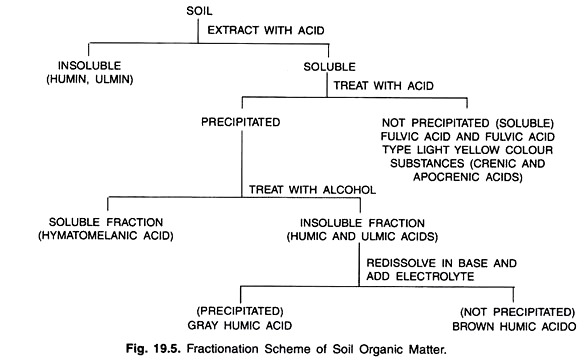ADVERTISEMENTS:
After reading this article you will learn about:- 1. Process of Humus Formation 2. Modern Views of Humus Formation 3. Concept.
Process of Humus Formation:
The formation of humus is strictly a biochemical process and rather complicated one. “Humus is defined as a complex and rather resistant mixture of brown or dark brown amorphous and colloidal substances modified from the original tissues or synthesized by the various soil organisms”. It is a natural body having variable and heterogeneous mass.
Humification of organic residues incorporating the soil depends upon their chemical composition and soil conditions influencing the activity of soil micro-organisms. On reaching the soil, organic residues of plant and animal origin undergo diverse changes brought about by various factors.
ADVERTISEMENTS:
Some of these changes take place without the participation of microorganisms which are as follows:
(a) Destructive changes due to the physical action of natural factors (rainfall, wind etc.) and to the action of man (soil cultivation).
(b) Changes in the chemical nature of organic residues under the direct action of water, light, air and reaction of the medium, e.g. the oxidation of fats and resins in light, the oxidation of aromatic compounds under alkaline soil conditions etc.
(c) Changes resulting from the effect of tissue enzymes, whose action, in dead cells, has a uni-directional, pre-dominantly oxidative character (e.g. oxidation of tannins, polyphenols and other aromatic amino acids etc.) forming complex dark-coloured condensation products.
ADVERTISEMENTS:
Humus formation from the residues of plant and animal is two-stage process:
1. The decomposition of the original components of tissues and their conversion by micro-organisms into simpler chemical compounds and partially to products of complete mineralization (CO2, NO2, NO3, NH3, CH4, H2O etc.).
2. The synthesis of organic compounds with the formation of high molecular-weight humus substances of specific nature. Micro-organisms participate mainly in the first stage of humus formation the decomposition of the fresh organic materials and the synthetic activity is limited to the re-synthesis of bacterial plasma. In the second stage of humus formation i.e. the condensation reactions (physico-chemical reactions) can take place without the participation of microorganisms.
Humus or soil organic matter consists of two major types of compounds-un-humified and humified residues of plant and animal. The un-humified substances are represented by certain organic compounds like, carbohydrates, fats, waxes and proteins.
ADVERTISEMENTS:
The soil, being a graveyard for the bodies of micro-organisms, can be expected to contain essentially all the biochemical compounds synthesized by bacteria, actinomycetes and fungi.
On the other hand, the humified fractions are considered as the most active part of humus which consists of a series of highly acidic, yellow to black-coloured, high molecular weight polyelectrolytes known as humic acid, fulvic acid and so on. A simple fractionation scheme for soil organic matter or humus is depicted below (Fig. 19.5).
Based on solubilities, the group is generally divided into three classes:
ADVERTISEMENTS:
(i) Fulvic acid, which is thought to be of the lowest molecular weight and is alkali and acid soluble,
(ii) Humic acid which is of medium molecular weight, alkali-soluble and acid-insoluble,
(iii) Humin which is apparently of the highest molecular weight and is insoluble in both alkali and acid except under most drastic conditions.
Modern Views of Humus Formation:
It is generally accepted that humic and fulvic acids are formed by a multiple stage that includes:
ADVERTISEMENTS:
(i) Decomposition of all plant components, including lignin, into simpler monomers;
(ii) Metabolism of the monomers with an accompanying increase in the soil biomass;
(iii) Repeated recycling of the biomass C (and N) with synthesis of new cells; and
(iv) Concurrent polymerization of reactive monomers into high-molecular weight polymers.
According to present day concepts, polyphenols derived from plants (e.g. lignin), or synthesized by micro-organisms, are enzymatically converted to quinones, which undergo self-condensation or combine with amino-compounds to form N-containing polymers. An overall scheme for the formation of humic acid from the polyphenols is shown below (Fig. 19.6).
Concepts of Humus Formation:
A. Flaig’s Concept of Humus Formation:
The concept of humus formation as described by Flaig is given below:
1. Lignin, freed of its linkage with cellulose during decomposition of plant residues, is subjected to oxidative splitting with formation of primary structural units (derivatives of phenyl-propane).
2. The side-chains of the lignin-building units are oxidised, de-methylation occurs, and the resulting polyphenols are converted to quinones by poly-phenol-oxidase enzymes.
3. Quinones arising from lignin (as well as from other sources) react with N-containing compounds to form dark-coloured polymers.
B. Kononova’s Concept of Humus Formation:
There are three stages leading to the formation of humic substances which are as follows:
Stage 1:
Fungi attack simple carbohydrates and parts of the protein and cellulose in the medullary rays, cortex of plant residues.
Stage 2:
Cellulose of the xylem is decomposed by aerobic myxobacteria. Polyphenols synthesized by the myxobacteria are oxidised to quinones by poly-phenol-oxidase enzymes, and the quinones subsequently react with N compounds to form brown humic substances.
Stage 3:
Lignin is decomposed. Phenols released during decay also serve as source materials for humus synthesis.



Comments are closed.